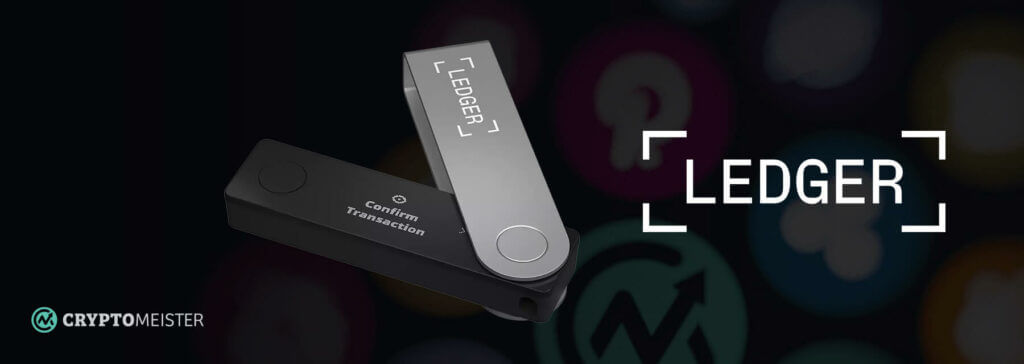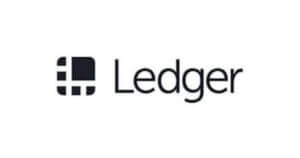Ledger wallet Review
When it comes to looking after your digital assets, there’s no better combination of security and convenience than a hardware wallet. Hardware wallets have been around since 2014, and they have come on in leaps and bounds in the years since, with functionality now matching the ever-present security features.
One of the OGs in the hardware wallet space is Ledger. Ledger was formed in 2014 and has produced numerous wallets over the years, each of which has taken this niche sector to the next level.
A Ledger hardware wallet is almost a byword for crypto security, and in this Ledger review we look at what you can do with a Ledger wallet, what’s good and what’s not so good about them and how they stack up to the competition.
What is a Ledger hardware wallet?

A Ledger wallet is a device that resembles a USB thumb drive and allows you to store your digital assets, such as cryptocurrencies and NFTs, offline. This is called a ‘cold’ wallet. This is best practice for those who don’t use their assets on a daily basis, as they represent the best defense against hackers.
A Ledger cold wallet allows you to receive, send, and store thousands of cryptocurrencies and NFTs, with access to the assets restricted to those with physical access to the device.
As well as storing cryptocurrencies and NFTs, the most powerful Ledger wallet also allows you to stake some cryptocurrencies, meaning you can earn passive income while securely holding the coins offline.
Another benefit of a Ledger hardware wallet is that even if the physical device itself is lost or destroyed, the accounts connected to it can be loaded onto a new device, meaning you will never lose access to the assets themselves.
Ledger has made three hardware wallets to date – the Ledger Nano S, its first wallet, which launched in 2016 (now discontinued); the Ledger Nano X which it launched in 2019; and the Ledger Nano S Plus which it introduced in 2022 to replace the Nano S.
How does a Ledger wallet work?
A Ledger wallet makes it much harder for someone other than the wallet’s owner to move the assets inside it. If you hold cryptocurrencies or NFTs in a wallet on your phone or computer, or leave them on an exchange, your wallet details are held on a server somewhere.
This is called a ‘hot’ wallet. If a hacker gets access to that server then they can potentially get into your wallet behind the scenes and move your assets without you knowing.
A Ledger cold wallet however is a self-contained entity not connected to a server, or even to the internet, until you want to interact with it. No one can hack into a Ledger hardware wallet and the assets associated with it can only be moved from the device by someone with physical access to it.
This means that, as long as you take certain precautions we’ll outline later, a Ledger cold wallet is essentially unhackable.
To send assets using a Ledger wallet, you need to make use of one of a number of compatible apps, either on your phone or computer, depending which model you have.
Ledger’s own software, Ledger Live, allows you to manage your device and assets, including upgrading the firmware as well as managing the apps that dictate which coins and assets you can store, but there are other third-party protocols you can use too. Popular ones include Metamask, WalletConnect and MyEtherWallet. This involves connecting your Ledger wallet to the device in question, either by bluetooth or a USB cable.
Supported cryptocurrencies
As you would expect from one of the leading cryptocurrency hardware wallet makers, Ledger’s cryptocurrency support is vast. Its wallets boast support for more than 5,500 cryptocurrencies, covering a multitude of blockchains. Having support for Ethereum means that any ERC-20 tokens are supported by Ledger wallets using just one Ethereum address.
Naturally, Ledger supports the top cryptocurrencies and a range of stablecoins, with staking enabled for some coins and the ability to use your Ledger hardware wallet with a number of other software wallets, such as Electrum, MyEtherWallet, MyCrypto and Binance.
Ledger provides a full list of supported coins here, but some of the most popular coins that Ledger wallets support are:
- Bitcoin (BTC)
- Ethereum (ETH)
- Polkadot (DOT)
- Ripple (XRP)
- Tether (USDT)
- Litecoin (LTC)
- Binance Coin (BNB)
- Stellar (XLM)
- Chainlink (LINK)
- Shiba Inu (SHIB)
- Cardano (ADA)
- Tezos (XTZ)
If you’re an NFT fan, you’ll be pleased to know that Ledger wallets support all NFTs on the Ethereum or Polygon blockchains, keeping your precious JPEGs safe and sound while you sleep.
Ledger Wallets – the lowdown
Price
The Ledger Nano S Plus retails at around $80 while the more advanced Ledger Nano X retails at $150. This puts Ledger devices in the middle-upper end of the hardware wallet price spectrum, but online reviews suggest that customers believe that the price is worth the security and features Ledger devices offer.
Security
The reason why a Ledger hardware wallet is so secure is because all transactions carried out on it require physical access to the device, with buttons needing to be pushed to confirm transactions. There is one caveat to this, which we will come onto shortly.
Ledger devices are highly resistant to tampering and illicit access due to their use of a Secure Element. This is a type of chip commonly used in passports, credit cards and payment systems, with Ledger using it to generate and store the private key for your wallet, which does not leave your device.
This brings us to the caveat. A wallet’s private key is what denotes ownership – if you have the private key to a wallet you can do anything with it and its contents. Ledger devices do not divulge or display the private key.
Instead they give you a Recovery Phrase – a string of 24 random words that you can use to recover access to your assets on another device. You MUST keep this Recovery Phrase secure, because if someone else gets hold of it they can take everything in that wallet without needing physical access.
Setup
Setting up a Ledger wallet is very easy, and there are plenty of tutorial videos out there to guide you through. The process is slightly different for the different models, but the principle is the same – once you boot it up you’ll either create a new wallet or you can import an old wallet using an existing Recovery Code.
As well as choosing a Recovery Code, you will also be asked to choose a PIN for the device. You’ll use this PIN every time you want to access the wallet for extra security.
Once you’ve taken these steps you’ll be asked to visit the Ledger Live app to select the blockchains you want support for. Each different blockchain (e.g. Bitcoin, Ethereum, Polkadot) has an app assigned to it – without the app installed you can’t create an address to send to. Once you’ve installed your apps you can start receiving cryptocurrencies and NFTs, using either Ledger Live or a compatible third-party wallet to reveal your addresses.
Competition
Ledger wasn’t the first crypto hardware wallet creator on the market. That honor belongs to Trezor, and it is Trezor wallets that arguably present the toughest competition for Ledger. Trezor wallets are equal in the most fundamental aspects hardware-wise, although its latest offering, the Model T, has a color touchscreen which makes verifying information and confirming transactions easier.
However, the price point is considerably higher than Trezor’s premium Nano X model, and Ledger wallets can connect to mobile devices (Nano S Plus cannot connect to iOS), whereas Trezors cannot.
There is also a move afoot to make hardware devices more affordable, which is the premise behind another Ledger competitor, Safepal. Safepal uses a built-in camera to scan QR codes and, with a price tag of around a third that of Ledger’s Nano X, it certainly will appeal to those looking for a less premium hardware wallet.
Ledger Nano S Plus vs Ledger Nano X
As we mentioned earlier, Ledger has two devices on the market at present – the Ledger Nano X and the Ledger Nano S Plus, which replaced the older Nano S in 2022.
Ledger has a handy side by side comparison on its website so you can see which is the best for you (considering the $70 price gap, this is worth doing), but it’s clear that the Nano S Plus was Ledger’s way of making a more affordable unit that didn’t compromise on security.
Essentially the Nano S Plus is a Nano X without the battery and the bluetooth connection but with the advantage of being smaller and lighter as a result. This means that you need to plug the Nano Plus S into a device to use it, a restriction that the Nano X doesn’t have, but in every other meaningful respect they are identical. Note however that the Nano S Plus cannot connect to iOS devices.
The Ledger Nano S also has its buttons sitting proud on top of the body, whereas the Nano X has them built cleverly into the device, but this is purely a style choice.
Overall, $70 for a battery, bluetooth connection and built-in buttons probably isn’t worth it.
The verdict
Ledger is probably the biggest name in the hardware wallet world for a good reason – its original Ledger Nano S was a seminal product that arrived just as crypto exploded, which really put it on the map.
The evolution into the Ledger Nano X has refined an already impressive design, and the security aspects of the two devices really are second to none. Throw in NFT support and staking and you have a device that can suddenly do many things without sacrificing security.
However, one thing we haven’t mentioned in this Ledger review yet is the massive data breach in 2020 that saw Ledger’s reputation shredded. That year the company experienced multiple breaches that saw 292,000 customers’ names, email addresses, home addresses and telephone numbers stolen, playing down the suggestions until the data was actually leaked online.
This was not only a major embarrassment for the security-focused company, but led to plenty of people swearing they would never touch Ledger devices again.
This may well have been a one off, and the episode doesn’t reflect on the quality of Ledger’s products, but it is nevertheless something that will live long in the memories of many.
This aside, we can safely say that Ledger is firmly at the top of the tree when it comes to quality hardware wallets, and with its Nano S Plus offering almost all the key features that the Nano X can but for a much reduced price, Ledger may have just done enough to keep the more budget-friendly competitors at bay.


